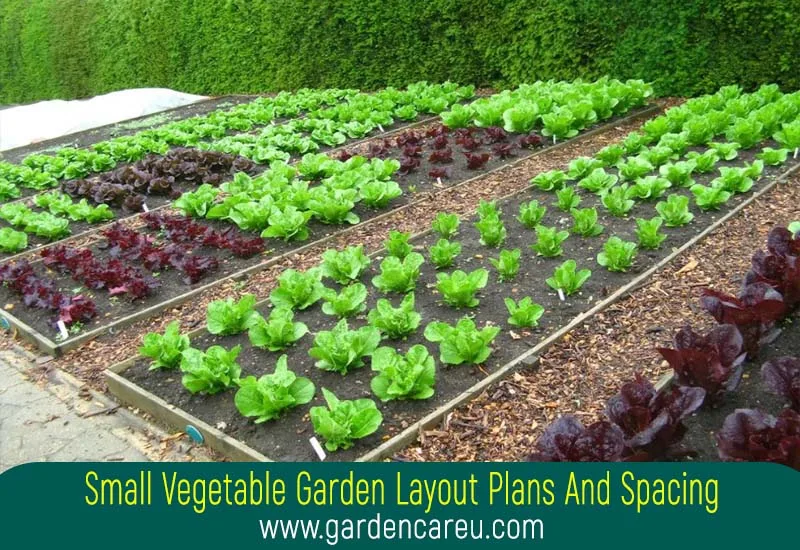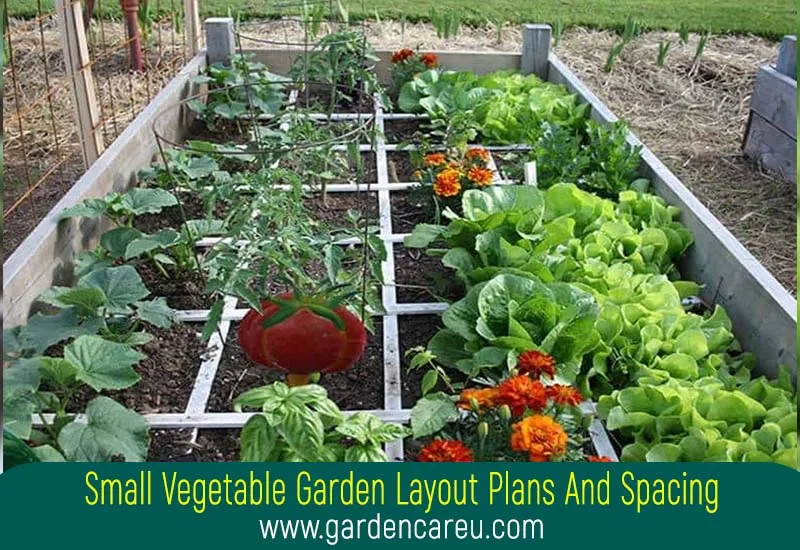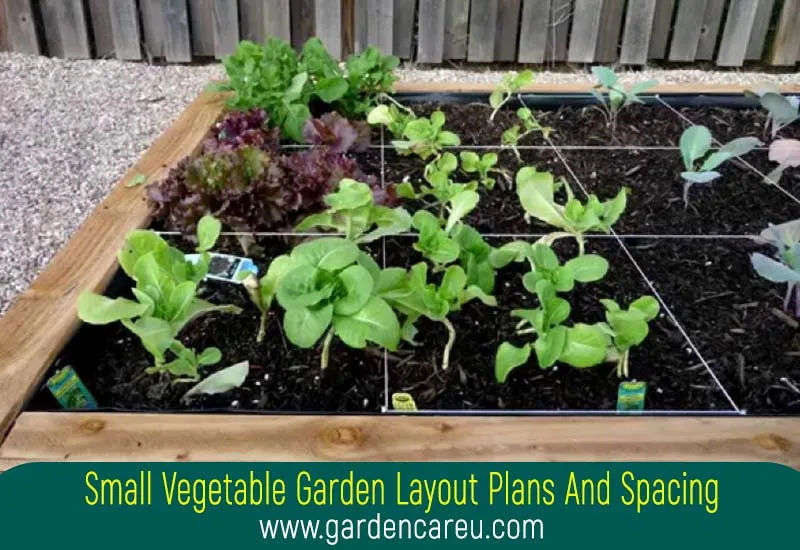Small vegetable garden layout plans and spacing are essential for optimizing the productivity and efficiency of your garden. This article will cover the fundamental principles of designing an effective vegetable garden layout, including the arrangement of plants, spacing between them, and other important considerations to ensure a successful harvest.
By following these guidelines, you can create a well-organized and thriving vegetable garden that maximizes the use of space and promotes healthy plant growth. Whether you have limited space or a larger area to work with, the tips and ideas provided here will help you make the most of your vegetable garden.
[ez-toc]
Benefits Of Small Vegetable Gardens
Small vegetable garden layout plans and spacing offer numerous benefits, such as maximizing yield in limited areas, easy maintenance, and accessibility to fresh produce. These gardens can be designed to fit any space, making it easier to grow your food, even with limited resources.
Small vegetable gardens offer numerous advantages, making them a popular choice for urban dwellers or those with limited space. With thoughtful planning and proper spacing, these gardens can still yield abundant crops while providing healthier and more nutritious produce. Let’s explore the benefits of small vegetable gardens in more detail:

Higher Yield In Small Spaces
Despite their limited size, small vegetable gardens can produce a remarkable amount of crops when planned and designed efficiently. By incorporating smart layout plans and spacing techniques, every inch of your garden can be maximized for optimum yield. Utilizing vertical gardening methods such as trellises, hanging containers, or tiered planting beds can further increase your productivity, allowing you to grow more vegetables in the same compact area.
Healthier And More Nutritious Produce
One of the significant benefits of small vegetable gardens is that they tend to produce healthier and more nutritious produce. Since the gardens are typically closer to your living space, it becomes easier to manage and monitor the overall health of your plants. With greater attention and care, you can promptly address any signs of pests or diseases, resulting in healthier and less chemically treated crops.
Additionally, small vegetable gardens often encourage organic gardening practices, such as using compost from kitchen scraps or natural pest control methods. By reducing the use of synthetic fertilizers and pesticides, you can cultivate produce that is free from harmful chemicals, leading to a more nutritious harvest that benefits both your body and the environment.

Planning Your Small Vegetable Garden
Planning a small vegetable garden? Get the most out of your space with well-designed layout plans and proper spacing.
Planning your small vegetable garden requires careful consideration of various factors to ensure successful growth and productivity. In this section, we will discuss the key aspects of planning your garden, including choosing the right location, determining the size of your garden, considering sunlight and shade, and soil preparation and testing.
Choosing The Right Location
When selecting a location for your small vegetable garden, there are a few important factors to keep in mind. Look for an area that receives ample sunlight throughout the day, as most vegetables require at least six hours of direct sunlight to thrive. Additionally, choose a spot that is sheltered from strong winds, as these can damage delicate plants. Lastly, ensure that the location has good drainage to prevent waterlogging, as excessive moisture can lead to root rot and other problems.
Determining The Size Of Your Garden
Before diving into the planting process, it is crucial to determine the size of your small vegetable garden. Consider the available space you have and the amount of time and effort you can dedicate to maintenance. Starting small is often a wise choice for beginners, as it allows you to gain experience without becoming overwhelmed. As you become more comfortable and confident, you can gradually expand the size of your garden.
Considering Sunlight And Shade
Sunlight is one of the most vital factors for the success of your vegetable garden. Different types of vegetables have varying sunlight requirements, so it’s important to plan accordingly. Take note of any nearby structures or trees that may cast shadows, as this can affect the sunlight exposure your plants receive. If you have limited space, consider planting taller crops towards the north side of your garden to avoid shading smaller plants.
Soil Preparation And Testing
Proper soil preparation is essential for healthy vegetable growth. Begin by removing any weeds or debris from the chosen area. Test your soil to determine its pH level and nutrient content, as this information will help you make informed decisions about soil amendments and fertilizer application. Incorporate organic matter, such as compost or well-rotted manure, to improve soil structure, drainage, and nutrient availability.
Remember to mix these organic materials evenly throughout the planting area to ensure uniform growth. Planning your small vegetable garden involves thoughtful consideration of the location, size, sunlight exposure, and soil preparation. By taking these factors into account, you can create an optimal environment for your vegetables to flourish. Remember, a well-planned garden is the foundation for a bountiful harvest.
Popular Small Vegetable Garden Layouts
When it comes to planning your small vegetable garden, choosing the right layout can make all the difference. A well-designed layout not only maximizes the use of available space but also ensures that your plants thrive and produce a bountiful harvest. There are several popular small vegetable garden layouts to consider, each with its unique advantages. Whether you prefer traditional rows, space-saving square-foot gardening, vertical structures, or the versatility of containers, there is a layout to suit your needs.
Row Gardening
Row gardening is a classic and straightforward layout where vegetables are planted in straight rows with walking paths in between. This layout is ideal for larger plots or gardens with ample space. Rows allow for easy access and maintenance, as well as efficient irrigation and pest management. It’s important to leave enough space between rows to accommodate the full growth of each plant and provide room for watering and harvesting. For smaller gardens, the row gardening layout can still be used but on a smaller scale, with fewer rows and more compact spacing between plants.
Square Foot Gardening
Square foot gardening is a space-saving technique that involves dividing your garden into small, equal-sized sections usually measuring 1 foot by 1 foot. Each section is then planted with a specific number of plants based on their size, ensuring efficient utilization of space. This method eliminates the need for traditional rows and allows for intensive planting. Square foot gardening is perfect for small gardens or even containers placed on patios or balconies. By focusing on a small area, you can easily manage and maintain your vegetable garden while maximizing productivity.
Vertical Gardening
Vertical gardening is a popular choice for those with limited ground space. This layout utilizes walls, fences, trellises, or other vertical structures to grow vegetables vertically. By training plants to grow upward, you can maximize space and create a visually appealing garden. Vining vegetables like tomatoes, cucumbers, and beans thrive in vertical gardening setups. Additionally, vertical gardening makes harvesting and pest control easier as the plants are at eye level. Consider using sturdy supports and ensuring adequate access to sunlight for successful vertical gardening.
Container Gardening
Container gardening offers versatility and flexibility, making it an excellent option for those without access to a traditional garden space. In this layout, vegetables are planted in containers such as pots, raised beds, or even hanging baskets. Containers can be placed on balconies, rooftops, or any sunny spot you have available. The key to successful container gardening is choosing the right size and type of container, providing appropriate soil, and ensuring proper drainage. With container gardening, you have the freedom to move your plants as needed and create a visually appealing garden even in limited spaces.
Optimizing Spacing In Your Vegetable Garden
Proper Plant Spacing
When planning your small vegetable garden layout, it’s crucial to ensure proper plant spacing to promote healthy growth and maximize your harvest. Each plant has specific space requirements, and overcrowding can lead to competition for nutrients, sunlight, and water, ultimately stunting growth and reducing yields. Following recommended spacing guidelines is essential for the overall well-being of your garden.
Companion Planting
Companion planting involves strategically growing certain plants near enhance growth, deter pests, and improve flavor. By intermingling compatible plant species, you can create a balanced ecosystem that benefits all plants. For example, pairing legumes with leafy greens can improve soil nitrogen, while planting marigolds near tomatoes can help repel harmful insects.
Intercropping
Intercropping refers to the practice of growing different crops together in the same space. This method maximizes yields by utilizing space more efficiently. For instance, planting taller crops, such as corn, alongside lower-growing vegetables, like squash, can optimize sunlight exposure and make the most of limited garden space.
Succession Planting
Succession planting involves sequentially planting crops in the same space throughout the growing season to make the most of available space. As soon as one crop is harvested, another is immediately sown, ensuring a continuous harvest and efficient use of space. This approach enables you to yield multiple crops from the same area and extend the productivity of your garden.
Tips For Maximizing Yield In A Small Vegetable Garden
Maximizing the yield in a small vegetable garden requires strategic planning and proper maintenance to ensure that your plants flourish. By implementing effective techniques such as crop rotation, mulching and watering, weed and pest control, and regular maintenance and harvesting, you can optimize your garden space and improve the overall productivity of your crops. Let’s delve into these essential tips that will help you make the most of your small vegetable garden.
Crop Rotation
Crop rotation is a crucial practice that involves changing the location of vegetables in your garden from one season to the next to minimize the risk of soil-borne diseases and nutrient depletion. By rotating the crops, you can naturally restore the soil’s fertility and prevent any particular pest or disease from becoming dominant.
Mulching And Watering
Mulching is key to conserving moisture, suppressing weeds, and improving soil quality. It also assists in maintaining an optimal temperature for root growth. Proper watering is essential, ensuring that the plants receive adequate moisture without being overwatered, which can lead to root rot. Use a soaker hose or drip irrigation system to ensure targeted watering.
Weed And Pest Control
To protect your crops, it is vital to control weeds and pests. Regularly remove weeds to prevent them from competing with your vegetables for nutrients and water. Employ natural predators, companion planting techniques, and organic solutions to keep pests at bay without harming the beneficial organisms in your garden.
Regular Maintenance And Harvesting
Regular maintenance such as pruning, staking, and fertilizing is essential for the healthy growth of vegetables. Additionally, timely harvesting promotes continuous production and encourages the development of new fruits. By staying on top of these tasks, you can ensure that your plants remain vibrant and productive throughout the growing season.

Frequently Asked Questions On Small Vegetable Garden Layout Plans And Spacing
How Do You Layout A Small Vegetable Garden?
To lay out a small vegetable garden: 1. Choose a sunny spot with well-draining soil. 2. Plan the layout by considering the spacing and the size of your chosen vegetables. 3. Use raised beds or containers to maximize space and minimize weeds.
4. Consider vertical gardening and companion planting to optimize space. 5. Regularly maintain and water the garden for healthy growth.
What Is The Spacing For Vegetable Garden Layout?
Vegetable garden spacing depends on the type of plants. Generally, leave 12-24 inches between rows and 12-36 inches between plants within a row. This allows enough space for plants to grow, receive sunlight, and ensure proper air circulation. Proper spacing helps prevent overcrowding and improves overall plant health and productivity.
What Is The Row Spacing For A Small Garden?
For a small garden, the ideal row spacing is typically 18 to 24 inches. This allows for efficient use of space and proper air circulation for the plants. Ensure to adjust based on the specific requirements of each crop.
What Vegetables Should Not Be Planted Next To Each Other?
Certain vegetables should not be planted next to each other due to compatibility issues. For instance, you should avoid planting tomatoes near potatoes, as they are vulnerable to similar diseases. Similarly, planting beans near onions can hinder the growth of both plants.
Conclusion
In this blog post, we have discussed various small vegetable garden layout plans and spacing. By following the tips and guidelines provided, you can effectively maximize your gardening space and achieve a bountiful harvest. Whether you have a small balcony or a backyard, these strategies can help you create a productive and visually appealing vegetable garden.
Start planning and enjoy the satisfaction of growing your own fresh and healthy produce. Happy gardening!


